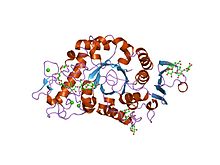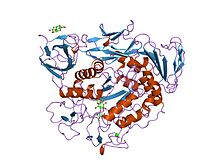α -Amylase
 | |||||||||
| Identifiers | |||||||||
| EC no. | 3.2.1.1 | ||||||||
| CAS no. | 9000-90-2 | ||||||||
| Databases | |||||||||
| IntEnz | IntEnz view | ||||||||
| BRENDA | BRENDA entry | ||||||||
| ExPASy | NiceZyme view | ||||||||
| KEGG | KEGG entry | ||||||||
| MetaCyc | metabolic pathway | ||||||||
| PRIAM | profile | ||||||||
| PDB structures | RCSB PDB PDBe PDBsum | ||||||||
| |||||||||
| GH13 catalytic domain | |||||||||
|---|---|---|---|---|---|---|---|---|---|
 Cyclodextrin glucanotransferase (e.c.2.4.1.19) (cgtase) | |||||||||
| Identifiers | |||||||||
| Symbol | Alpha-amylase | ||||||||
| Pfam | PF00128 | ||||||||
| Pfam clan | CL0058 | ||||||||
| InterPro | IPR006047 | ||||||||
| SCOP2 | 1ppi / SCOPe / SUPFAM | ||||||||
| OPM superfamily | 117 | ||||||||
| OPM protein | 1wza | ||||||||
| CAZy | GH13 | ||||||||
| CDD | cd11338 | ||||||||
| |||||||||
| Alpha-amylase C-terminal beta-sheet domain | |||||||||
|---|---|---|---|---|---|---|---|---|---|
 Crystal structure of barley alpha-amylase isozyme 1 (amy1) inactive mutant d180a in complex with maltoheptaose | |||||||||
| Identifiers | |||||||||
| Symbol | Alpha-amyl_C2 | ||||||||
| Pfam | PF07821 | ||||||||
| InterPro | IPR012850 | ||||||||
| |||||||||
| Alpha amylase, C-terminal all-beta domain | |||||||||
|---|---|---|---|---|---|---|---|---|---|
 maltotriose complex of preconditioned cyclodextrin glycosyltransferase mutant | |||||||||
| Identifiers | |||||||||
| Symbol | Alpha-amylase_C | ||||||||
| Pfam | PF02806 | ||||||||
| Pfam clan | CL0369 | ||||||||
| InterPro | IPR006048 | ||||||||
| SCOP2 | 1ppi / SCOPe / SUPFAM | ||||||||
| |||||||||
- Endohydrolysis of (1→4)-
α -D-glucosidic linkages in polysaccharides containing three or more (1→4)-α -linked D-glucose units
It is the major form of amylase found in humans and other mammals.[3] It is also present in seeds containing starch as a food reserve, and is secreted by many fungi. It is a member of glycoside hydrolase family 13.
In human biology
[edit]Although found in many tissues, amylase is most prominent in pancreatic juice and saliva, each of which has its own isoform of human
Salivary amylase (ptyalin)
[edit]Amylase is found in saliva and breaks starch into maltose and dextrin. This form of amylase is also called "ptyalin" /ˈtaɪəlɪn/, which was named by chemist Jöns Jacob Berzelius. The name derives from the Greek word
Optimum conditions for ptyalin
[edit]- Optimum pH – 7.0;[7] 5.6-6.9[8]
- Human body temperature - 37 degrees Celsius[8]
- Presence of certain anions and activators:
Genetic variation in human salivary amylase
[edit]The salivary amylase gene has undergone duplication during evolution, and DNA hybridization studies indicate many individuals have multiple tandem repeats of the gene. The number of gene copies correlates with the levels of salivary amylase, as measured by protein blot assays using antibodies to human amylase. Gene copy number is associated with apparent evolutionary exposure to high-starch diets.[9] For example, a Japanese individual had 14 copies of the amylase gene (one allele with 10 copies, and a second allele with four copies). The Japanese diet has traditionally contained large amounts of rice starch. In contrast, a Biaka individual carried six copies (three copies on each allele). The Biaka are rainforest hunter-gatherers who have traditionally consumed a low-starch diet. Perry and colleagues speculated the increased copy number of the salivary amylase gene may have enhanced survival coincident to a shift to a starchy diet during human evolution.
Pancreatic amylase
[edit]Pancreatic
In pathology
[edit]The test for amylase is easier to perform than that for lipase, making it the primary test used to detect and monitor pancreatitis. Medical laboratories will usually measure either pancreatic amylase or total amylase. If only pancreatic amylase is measured, an increase will not be noted with mumps or other salivary gland trauma.
However, because of the small amount present, timing is critical when sampling blood for this measurement. Blood should be taken soon after a bout of pancreatitis pain, otherwise it is excreted rapidly by the kidneys.
Salivary
Interpretation
[edit]Increased plasma levels in humans are found in:
- Salivary trauma (including anaesthetic intubation)
- Mumps – due to inflammation of the salivary glands
- Pancreatitis – because of damage to the cells that produce amylase
- Kidney failure – due to reduced excretion
Total amylase readings of over 10 times the upper limit of normal (ULN) are suggestive of pancreatitis. Five to 10 times the ULN may indicate ileus or duodenal disease or kidney failure, and lower elevations are commonly found in salivary gland disease.
Genes
[edit]In grain
[edit]Industrial use
[edit]The first step in the production of high-fructose corn syrup is the treatment of cornstarch with
An
See amylase for more uses of the amylase family in general.
Potential for medical use
[edit]Buffer inhibition
[edit]The tris molecule is reported to inhibit a number of bacterial
Determination
[edit]Several methods are available for determination of
Modified colorimetric microdetermination of amylase is described in which the digestion of starch is measured by the decrease in the starch-iodine color.[20]
Domain architecture
[edit]See also
[edit]References
[edit]- ^ Ramasubbu N, Paloth V, Luo Y, Brayer GD, Levine MJ (May 1996). "Structure of human salivary
α -amylase at 1.6 Å resolution: implications for its role in the oral cavity". Acta Crystallographica D. 52 (Pt 3): 435–46. doi:10.1107/S0907444995014119. PMID 15299664. - ^ Kierulf P. "Amylase". Store Medisinske Leksikon. Store Norske Leksikon. Retrieved 24 January 2021.
- ^ Voet D, Voet JG (2005). Biochimie (2nd ed.). Bruxelles: De Boeck. p. 1583.
- ^ J. Berzelius (Ms. Esslinger, trans.), Traité de Chimie (Paris, France: Firmin Didot Frerès, 1833), vol. 7, page 156.
- ^ Fried M, Abramson S, Meyer JH (October 1987). "Passage of salivary amylase through the stomach in humans". Digestive Diseases and Sciences. 32 (10): 1097–103. doi:10.1007/bf01300195. PMID 3652896. S2CID 24845837.
- ^ Rosenblum JL, Irwin CL, Alpers DH (May 1988). "Starch and glucose oligosaccharides protect salivary-type amylase activity at acid pH". The American Journal of Physiology. 254 (5 Pt 1): G775–80. doi:10.1152/ajpgi.1988.254.5.G775. PMID 2452576.
- ^ "Amylase, Alpha – Worthington Enzyme Manual". worthington-biochem.com. Archived from the original on 14 October 2016.
- ^ a b Valls, Cristina; Rojas, Cristina; Pujadas, Gerard; Garcia-Vallve, Santi; Mulero, Miquel (July 2012). "Characterization of the activity and stability of amylase from saliva and detergent: Laboratory practicals for studying the activity and stability of amylase from saliva and various commercial detergents". Biochemistry and Molecular Biology Education. 40 (4): 254–265. doi:10.1002/bmb.20612. PMID 22807429. S2CID 36680999.
- ^ a b Perry GH, Dominy NJ, Claw KG, Lee AS, Fiegler H, Redon R, Werner J, Villanea FA, Mountain JL, Misra R, Carter NP, Lee C, Stone AC (October 2007). "Diet and the evolution of human amylase gene copy number variation". Nature Genetics. 39 (10): 1256–60. doi:10.1038/ng2123. PMC 2377015. PMID 17828263.
- ^ Noto Y, Sato T, Kudo M, Kurata K, Hirota K (December 2005). "The relationship between salivary biomarkers and state-trait anxiety inventory score under mental arithmetic stress: a pilot study". Anesthesia and Analgesia. 101 (6): 1873–6. doi:10.1213/01.ANE.0000184196.60838.8D. PMID 16301277. S2CID 22252878.
- ^ Granger DA, Kivlighan KT, el-Sheikh M, Gordis EB, Stroud LR (March 2007). "Salivary
α -amylase in biobehavioral research: recent developments and applications". Annals of the New York Academy of Sciences. 1098 (1): 122–44. Bibcode:2007NYASA1098..122G. doi:10.1196/annals.1384.008. PMID 17332070. S2CID 222075003. - ^ Nater UM, Rohleder N (May 2009). "Salivary
α -amylase as a non-invasive biomarker for the sympathetic nervous system: current state of research". Psychoneuroendocrinology. 34 (4): 486–96. doi:10.1016/j.psyneuen.2009.01.014. PMID 19249160. S2CID 7564969. - ^ "Falling Number – Introduction". Perten Instruments. 2005. Archived from the original on 9 September 2009. Retrieved 21 November 2009.
- ^ Gatehouse AM, Davison GM, Newell CA, Merryweather A, Hamilton WD, Burgess EP, Gilbert RJ, Gatehouse JA (1997). "Transgenic potato plants with enhanced resistance to the tomato moth, Lacanobia oleracea: growth room trials". Molecular Breeding. 3 (1). Springer Science+Business: 49–63. doi:10.1023/a:1009600321838. ISSN 1380-3743. S2CID 23765916.
- ^ "The use of enzymes in detergents". Faculty of Engineering, Science and the Built Environment, London South Bank University. 20 December 2004. Archived from the original on 20 October 2009. Retrieved 21 November 2009.
- ^ Fleming D, Rumbaugh KP (April 2017). "Approaches to Dispersing Medical Biofilms". Microorganisms. 5 (2): 15. doi:10.3390/microorganisms5020015. PMC 5488086. PMID 28368320.
- ^ Fleming D, Chahin L, Rumbaugh K (February 2017). "Glycoside Hydrolases Degrade Polymicrobial Bacterial Biofilms in Wounds". Antimicrobial Agents and Chemotherapy. 61 (2): AAC.01998–16. doi:10.1128/AAC.01998-16. PMC 5278739. PMID 27872074.
- ^ Ghalanbor Z, Ghaemi N, Marashi SA, Amanlou M, Habibi-Rezaei M, Khajeh K, Ranjbar B (2008). "Binding of Tris to Bacillus licheniformis alpha-amylase can affect its starch hydrolysis activity". Protein and Peptide Letters. 15 (2): 212–4. doi:10.2174/092986608783489616. PMID 18289113.
- ^ Aghajari N, Feller G, Gerday C, Haser R (March 1998). "Crystal structures of the psychrophilic
α -amylase from Alteromonas haloplanctis in its native form and complexed with an inhibitor". Protein Science. 7 (3): 564–72. doi:10.1002/pro.5560070304. PMC 2143949. PMID 9541387. - ^ Pimstone, Neville R. (1964). "A Study of the Starch-Iodine Complex: A Modified Colourimetric Micro Determination of Amylase in Biological Fluids". Clinical Chemistry. 10 (10). American Association for Clinical Chemistry: 891–906. doi:10.1093/clinchem/10.10.891. Archived from the original on 14 May 2022.
- ^ Abe A, Yoshida H, Tonozuka T, Sakano Y, Kamitori S (December 2005). "Complexes of Thermoactinomyces vulgaris R-47 alpha-amylase 1 and pullulan model oligossacharides provide new insight into the mechanism for recognizing substrates with
α -(1,6) glycosidic linkages". The FEBS Journal. 272 (23): 6145–53. doi:10.1111/j.1742-4658.2005.05013.x. PMID 16302977. S2CID 41008169. - ^ Kadziola A, Søgaard M, Svensson B, Haser R (April 1998). "Molecular structure of a barley alpha-amylase-inhibitor complex: implications for starch binding and catalysis". Journal of Molecular Biology. 278 (1): 205–17. doi:10.1006/jmbi.1998.1683. PMID 9571044.
- ^ Kadziola A, Abe J, Svensson B, Haser R (May 1994). "Crystal and molecular structure of barley
α -amylase". Journal of Molecular Biology. 239 (1): 104–21. doi:10.1006/jmbi.1994.1354. PMID 8196040. - ^ Machius M, Wiegand G, Huber R (March 1995). "Crystal structure of calcium-depleted Bacillus licheniformis
α -amylase at 2.2 Å resolution". Journal of Molecular Biology. 246 (4): 545–59. doi:10.1006/jmbi.1994.0106. PMID 7877175.
External links
[edit]- The alpha-Amylase Protein
- alpha-Amylase at the U.S. National Library of Medicine Medical Subject Headings (MeSH)
